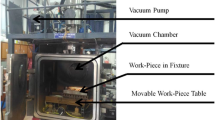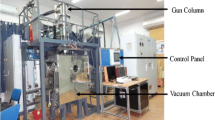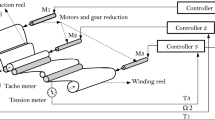Abstract
To automate the electron beam welding process, the identification of its contributing parameters is a must, for which it is required to establish the input–output correlations in both forward and reverse directions as accurately as possible. In the present investigation, both feed-forward and recurrent neural networks are developed for the said purposes, which have been trained using the welding data collected from an existing computational fluid dynamics (CFD)-based phenomenological model with the help of some natured-inspired optimization tools like cuckoo search, firefly, flower pollination, crow search algorithms, particle swarm optimization, covariance adaptation evolution strategy and spider monkey optimization, separately. The results of the trained networks have been validated using some real experimental data. The novelty of this study lies with the applications of these newly developed nature-inspired optimization algorithms to tune the neural networks using the CFD-based phenomenological model-generated welding data. In addition, the performances of these neural networks tuned using the said nature-inspired optimization algorithms have been compared through some statistical tests. In general, flower pollination-tuned recurrent neural network is found to provide the best predictions.


Similar content being viewed by others
References
Roy, G.G.; Zhang, Z.; Mishra, S.; He, X.; Fan, Y.; Kumar, A.; DebRoy, T.: A computer program to calculate fluid flow and heat transfer during fusion welding with free surface. Department of Materials Science and Engineering, Pennsylvania State University, University Park, Pennsylvania—16802 (2002)
Das, D.; Pratihar, D.K.; Roy, G.G.: Cooling rate predictions and its correlation with grain characteristics during electron beam welding of stainless steel. Int. J. Adv. Manuf. Technol. (2018). https://doi.org/10.1007/s00170-018-2095-6
Ganjigatti, J.P.; Pratihar, D.K.; Roychoudhury, A.: Modeling of the MIG welding process using statistical approaches. Int. J. Adv. Manuf. Technol. 35, 1166–1190 (2008). https://doi.org/10.1007/s00170-006-0798-6
Datta, S.; Pratihar, D.K.; Bandyopadhyay, P.P.: Modeling of plasma spray coating process using statistical regression analysis. Int. J. Adv. Manuf. Technol. 65, 967–980 (2013). https://doi.org/10.1007/s00170-012-4232-y
Pratihar, D.K.: Soft Computing Fundamentals and Applications. Narosa Publishing House Pvt. Ltd, New Delhi (2015)
Dutta, P.; Pratihar, D.K.: Modeling of TIG welding process using conventional regression analysis and neural network-based approaches. J. Mater. Process. Technol. 184, 56–68 (2007). https://doi.org/10.1016/j.jmatprotec.2006.11.004
Parappagoudar, M.B.; Pratihar, D.K.; Datta, G.L.: Forward and reverse mappings in green sand mould system using neural networks. Appl. Soft Comput. J. 8, 239–260 (2008). https://doi.org/10.1016/j.asoc.2007.01.005
Malviya, R.; Pratihar, D.K.: Tuning of neural networks using particle swarm optimization to model MIG welding process. Swarm Evol. Comput. 1, 223–235 (2011). https://doi.org/10.1016/j.swevo.2011.07.001
Jha, M.N.; Pratihar, D.K.; Bapat, A.V.; Dey, V.; Ali, M.; Bagchi, A.C.: Knowledge-based systems using neural networks for electron beam welding process of reactive material (Zircaloy-4). J. Intell. Manuf. 25, 1315–1333 (2014). https://doi.org/10.1007/s10845-013-0732-3
Das, A.K.; Pratihar, D.K.: Performance improvement of a genetic algorithm using a novel restart strategy with elitism principle. Int. J. Hybrid Intell. Syst. 15, 1–15 (2018). https://doi.org/10.3233/HIS-180257
Yang, X.-S.: Firefly algorithm, levy flights and global optimization. In: Bramer, M., Ellis, R., Petridis, M. (eds.) Research and Development in Intelligent Systems XXVI, pp. 209–218. Springer, London (2010)
Yang, X.S.; Deb, S.: Cuckoo search via Levy flights. In: Abraham, A., Carvalho, A., Herrera, F., Pai, V. (eds.) Nature and Biologically Inspired Computing (NABIC), pp. 210–214. IEEE, Coimbatore, India (2009). https://doi.org/10.1109/NABIC.2009.5393690
Yang, X.-S.: Flower pollination algorithm for global optimization. In: Durand-Lose, J., Jonoska, N. (eds.) Unconventional Computation and Natural Computation: 11th International Conference, UCNC 2012, pp. 240–249. Springer, Orléans (2012)
Askarzadeh, A.: A novel metaheuristic method for solving constrained engineering optimization problems: crow search algorithm. Comput. Struct. 169, 1–12 (2016). https://doi.org/10.1016/j.compstruc.2016.03.001
Bag, S.; De, A.; DebRoy, T.: A genetic algorithm-assisted inverse convective heat transfer model for tailoring weld geometry. Mater. Manuf. Process. 24, 384–397 (2009). https://doi.org/10.1080/10426910802679915
Manvatkar, V.D.; Arora, A.; De, A.; Debroy, T.: Neural network models of peak temperature, torque, traverse force, bending stress and maximum shear stress during friction stir welding. Sci. Technol. Weld. Join. 17, 460–466 (2012). https://doi.org/10.1179/1362171812Y.0000000035
Das, D.; Pratihar, D.K.; Roy, G.G.; Pal, A.R.A.: Phenomenological model-based study on electron beam welding process, and input–output modeling using neural networks trained by back-propagation algorithm, genetic algorithms, particle swarm optimization algorithm and bat algorithm. Appl. Intell. 48, 2698–2718 (2018). https://doi.org/10.1007/s10489-017-1101-2
Nandan, R.; DebRoy, T.; Bhadeshia, H.K.D.H.: Recent advances in friction-stir welding—process, weldment structure and properties. Prog. Mater Sci. 53, 980–1023 (2008). https://doi.org/10.1016/j.pmatsci.2008.05.001
He, X.; Elmer, J.W.; Debroy, T.: Heat transfer and fluid flow in laser microwelding. J. Appl. Phys. 97, 084909 (2005). https://doi.org/10.1063/1.1873032
Roy, G.G.; Elmer, J.W.; DebRoy, T.: Mathematical modeling of heat transfer, fluid flow, and solidification during linear welding with a pulsed laser beam. J. Appl. Phys. 100, 034903 (2006). https://doi.org/10.1063/1.2214392
Rai, R.; Roy, G.G.; Debroy, T.: A computationally efficient model of convective heat transfer and solidification characteristics during keyhole mode laser welding. J. Appl. Phys. 101, 054909 (2007). https://doi.org/10.1063/1.2537587
Rai, R.; Elmer, J.W.; Palmer, T.A.; DebRoy, T.: Heat transfer and fluid flow during keyhole mode laser welding of tantalum, Ti–6Al–4 V, 304L stainless steel and vanadium. J. Phys. D Appl. Phys. 40, 5753–5766 (2007). https://doi.org/10.1088/0022-3727/40/18/037
Rai, R.; Palmer, T.A.; Elmer, J.W.; Debroy, T.: Heat transfer and fluid flow during electron beam welding of 304L stainless steel alloy. Weld. J. 88, 54–61 (2009)
Khorram, A.; Ghoreishi, M.; Yazdi, M.R.S.; Moradi, M.: Optimization of bead geometry in CO2 laser welding of Ti 6Al 4 V using response surface methodology. Engineering 03, 708–712 (2011). https://doi.org/10.4236/eng.2011.37084
Srivastava, S.; Garg, R.K.: Process parameter optimization of gas metal arc welding on IS:2062 mild steel using response surface methodology. J. Manuf. Process. 25, 296–305 (2017). https://doi.org/10.1016/j.jmapro.2016.12.016
Torres-Treviño, L.M.; Reyes-Valdes, F.A.; López, V.; Praga-Alejo, R.: Multi-objective optimization of a welding process by the estimation of the Pareto optimal set. Expert Syst. Appl. 38, 8045–8053 (2011). https://doi.org/10.1016/j.eswa.2010.12.139
Buffa, G.; Fratini, L.; Micari, F.: Mechanical and microstructural properties prediction by artificial neural networks in FSW processes of dual phase titanium alloys. J. Manuf. Process. 14, 289–296 (2012). https://doi.org/10.1016/j.jmapro.2011.10.007
Mathew, J.; Griffin, J.; Alamaniotis, M.; Kanarachos, S.; Fitzpatrick, M.E.: Prediction of welding residual stresses using machine learning: comparison between neural networks and neuro-fuzzy systems. Appl. Soft Comput. 70, 131–146 (2018). https://doi.org/10.1016/j.asoc.2018.05.017
Vargas, J.A.R.; Pedrycz, W.; Hemerly, E.M.: Improved learning algorithm for two-layer neural networks for identification of nonlinear systems. Neurocomputing 329, 86–96 (2018). https://doi.org/10.1016/j.neucom.2018.10.008
Jha, M.N.; Pratihar, D.K.; Dey, V.; Saha, T.K.; Bapat, A.V.: Study on electron beam butt welding of austenitic stainless steel 304 plates and its input–output modelling using neural networks. Proc. Inst. Mech. Eng. Part B J. Eng. Manuf. 225, 2051–2070 (2011). https://doi.org/10.1177/0954405411404856
Reddy, D.Y.A.; Pratihar, D.K.: Neural network-based expert systems for predictions of temperature distributions in electron beam welding process. Int. J. Adv. Manuf. Technol. 55, 535–548 (2011). https://doi.org/10.1007/s00170-010-3104-6
Gao, X.D.; Zhang, Y.X.: Prediction model of weld width during high-power disk laser welding of 304 austenitic stainless steel. Int. J. Precis. Eng. Manuf. 15, 399–405 (2014). https://doi.org/10.1007/s12541-014-0350-9
Ruiz, L.G.B.; Rueda, R.; Cuéllar, M.P.; Pegalajar, M.C.: Energy consumption forecasting based on Elman neural networks with evolutive optimization. Expert Syst. Appl. 92, 380–389 (2018). https://doi.org/10.1016/j.eswa.2017.09.059
Ge, H.W.; Liang, Y.C.; Marchese, M.: A modified particle swarm optimization-based dynamic recurrent neural network for identifying and controlling nonlinear systems. Comput. Struct. 85, 1611–1622 (2007). https://doi.org/10.1016/j.compstruc.2007.03.001
Zhou, C.; Ding, L.Y.; He, R.: PSO-based Elman neural network model for predictive control of air chamber pressure in slurry shield tunneling under Yangtze River. Autom. Constr. 36, 208–217 (2013). https://doi.org/10.1016/j.autcon.2013.03.001
Nawi, N.M.; Khan, A.; Rehman, M.Z.; Herawan, T.; Deris, M.M.: CSLMEN: a new cuckoo search Levenberg Marquardt Elman network for data classification. In: Recent Advances on Soft Computing and Data Mining, pp. 173–182. Springer, Kluang (2014)
Guo, C.; Yan, J.; Tian, Z.: Analysis and design of an attitude calculation algorithm based on elman neural network for SINS. Clust. Comput. 8, 1–6 (2018). https://doi.org/10.1007/s10586-018-2562-8
Mehrgini, B.; Izadi, H.; Memarian, H.: Shear wave velocity prediction using Elman artificial neural network. Carbonates Evaporites (2017). https://doi.org/10.1007/s13146-017-0406-x
Nayak, J.; Naik, B.; Behera, H.S.; Abraham, A.: Elitist teaching–learning-based optimization (ETLBO) with higher-order Jordan Pi-sigma neural network: a comparative performance analysis. Neural Comput. Appl. 30, 1445–1468 (2018). https://doi.org/10.1007/s00521-016-2738-1
Rather, A.M.; Agarwal, A.; Sastry, V.N.: Recurrent neural network and a hybrid model for prediction of stock returns. Expert Syst. Appl. 42, 3234–3241 (2015). https://doi.org/10.1016/j.eswa.2014.12.003
Krichene, E.; Masmoudi, Y.; Alimi, A.M.; Abraham, A.; Chabchoub, H.: Forecasting using Elman recurrent neural network. In: International Conference on Intelligent Systems Design and Applications, pp. 488–497. Springer, Cham (2016)
Valian, E.; Mohanna, S.; Tavakoli, S.: Improved cuckoo search algorithm for feedforward neural network training. Artif. Intell. 2, 36–43 (2011). https://doi.org/10.5121/ijaia.2011.2304
Vazquez, R.A.: Training spiking neural models using cuckoo search algorithm. In: Evolutionary Computation (CEC), pp. 679–686. IEEE Congress (2011)
Swain, K.B.; Solanki, S.S.; Mahakula, A.K.: Bio inspired cuckoo search algorithm based neural network and its application to noise cancellation. In: Signal Processing and Integrated Networks (SPIN), pp. 632–635. IEEE (2014)
Gotmare, A.; Patidar, R.; George, N.V.: Nonlinear system identification using a cuckoo search optimized adaptive Hammerstein model. Expert Syst. Appl. 42, 2538–2546 (2015). https://doi.org/10.1016/j.eswa.2014.10.040
Goswami, D.; Chakraborty, S.: Optimal process parameter selection in laser transmission welding by cuckoo search algorithm. In: Proceedings of the International Conference on Advanced Engineering Optimization Through Intelligent Techniques (AEOTIT), Gujarat, India, pp. 40–44 (2013)
Chen, G.; Ding, X.: Optimal economic dispatch with valve loading effect using self-adaptive firefly algorithm. Appl. Intell. 42, 276–288 (2015). https://doi.org/10.1007/s10489-014-0593-2
Alweshah, M.; Abdullah, S.: Hybridizing firefly algorithms with a probabilistic neural network for solving classification problems. Appl. Soft Comput. J. 35, 513–524 (2015). https://doi.org/10.1016/j.asoc.2015.06.018
Nayak, J.; Naik, B.; Behera, H.S.: A novel nature inspired firefly algorithm with higher order neural network: performance analysis. Eng. Sci. Technol. Int. J. 19, 197–211 (2016). https://doi.org/10.1016/j.jestch.2015.07.005
Senthilkumar, N.; Tamizharasan, T.; Gobikannan, S.: Application of response surface methodology and firefly algorithm for optimizing multiple responses in turning AISI 1045 steel. Arab. J. Sci. Eng. 39, 8015–8030 (2014). https://doi.org/10.1007/s13369-014-1320-3
Chiroma, H.; Khan, A.; Abubakar, A.I.; Saadi, Y.; Hamza, M.F.; Shuib, L.; Gital, A.Y.; Herawan, T.: A new approach for forecasting OPEC petroleum consumption based on neural network train by using flower pollination algorithm. Appl. Soft Comput. J. 48, 50–58 (2016). https://doi.org/10.1016/j.asoc.2016.06.038
Acherjee, B.; Maity, D.; Kuar, A.S.: Parameters optimisation of transmission laser welding of dissimilar plastics using RSM and flower pollination algorithm integrated approach. Int. J. Math. Model. Numer. Optim. 8, 1–22 (2017). https://doi.org/10.1504/IJMMNO.2017.10004515
Draa, A.: On the performances of the flower pollination algorithm—qualitative and quantitative analyses. Appl. Soft Comput. J. 34, 349–371 (2015). https://doi.org/10.1016/j.asoc.2015.05.015
Singh, D.; Singh, U.; Salgotra, R.: An extended version of flower pollination algorithm. Arab. J. Sci. Eng. 43, 7573–7603 (2018). https://doi.org/10.1007/s13369-018-3166-6
Oliva, D.; Hinojosa, S.; Cuevas, E.; Pajares, G.; Avalos, O.; Gálvez, J.: Cross entropy based thresholding for magnetic resonance brain images using crow search algorithm. Expert Syst. Appl. 79, 164–180 (2017). https://doi.org/10.1016/j.eswa.2017.02.042
Nobahari, H.; Bighashdel, A.: MOCSA: a multi-objective crow search algorithm for multi-objective optimization. In: 2nd Conference on Swarm Intelligence and Evolutionary Computation (CSIEC), pp. 60–65. IEEE, Kerman (2017)
Abdelaziz, A.Y.; Fathy, A.: A novel approach based on crow search algorithm for optimal selection of conductor size in radial distribution networks. Eng. Sci. Technol. Int. J. 20, 391–402 (2017). https://doi.org/10.1016/j.jestch.2017.02.004
Mason, K.; Duggan, M.; Barrett, E.; Duggan, J.; Howley, E.: Predicting host CPU utilization in the cloud using evolutionary neural networks. Fut. Gener. Comput. Syst. 86, 162–173 (2018). https://doi.org/10.1016/j.future.2018.03.040
Mason, K.; Duggan, J.; Howley, E.: Forecasting energy demand, wind generation and carbon dioxide emissions in Ireland using evolutionary neural networks. Energy 155, 705–720 (2018). https://doi.org/10.1016/j.energy.2018.04.192
Cuevas, E.; Galvez, J.: An optimization algorithm guided by a machine learning approach. Int. J. Mach. Learn. Cybern. (2019). https://doi.org/10.1007/s13042-018-00915-0
Veloso De Melo, V.; Iacca, G.: A CMA-ES-based 2-stage memetic framework for solving constrained optimization problems. In: IEEE SSCI 2014–2014 IEEE Symposium Series on Computational Intelligence—FOCI 2014 2014 IEEE Symposium on Foundations of Computational Intelligence Proceedings, pp. 143–150 (2015). https://doi.org/10.1109/FOCI.2014.7007819
Jadon, S.S.; Tiwari, R.; Sharma, H.; Bansal, J.C.: Hybrid artificial bee colony algorithm with differential evolution. Appl. Soft Comput. J. 58, 11–24 (2017). https://doi.org/10.1016/j.asoc.2017.04.018
Kusakci, A.O.; Can, M.: A novel evolution strategy for constrained optimization in engineering design. In: 2013 24th International Conference on Information, Communication and Automation Technologies. ICAT 2013, pp. 1–6 (2013). https://doi.org/10.1109/icat.2013.6684072
Elmer, J.W.; Giedt, W.H.; Eager, T.W.: The transition from shallow to deep penetration during electron beam welding. Weld. J. 69, 167–176 (1990)
Kar, J.; Mahanty, S.; Roy, S.K.; Roy, G.G.: Estimation of average spot diameter and bead penetration using process model during electron beam welding of AISI 304 stainless steel. Trans. Indian Inst. Met. 68, 935–941 (2015). https://doi.org/10.1007/s12666-015-0529-5
Bansal, J.C.; Sharma, H.; Jadon, S.S.; Clerc, M.: Spider monkey optimization algorithm for numerical optimization. Memet. Comput. 6, 31–47 (2014). https://doi.org/10.1007/s12293-013-0128-0
Petrov, P.: Optimization of carbon steel electron-beam hardening. J. Phys. Conf. Ser. 223, 012029 (2010). https://doi.org/10.1088/1742-6596/223/1/012029
Das, D.; Pratihar, D.K.; Roy, G.G.: Electron beam melting of steel plates: temperature measurement using thermocouples and prediction through finite element analysis. In: Mandal, D.K., Syan, C.S. (eds.) CAD/CAM, Robotics and Factories of the Future, pp. 579–588. Springer, New Delhi (2016)
Datta, S.; Pratihar, D.K.; Bandyopadhyay, P.P.: Modeling of input–output relationships for a plasma spray coating process using soft computing tools. Appl. Soft Comput. 12, 3356–3368 (2012). https://doi.org/10.1016/j.asoc.2012.07.015
Yang, X.: Recent Advances in Swarm Intelligence and Evolutionary Computation, vol. 585. Springer, London (2015)
Yang, X.S.; Deb, S.: Cuckoo search: recent advances and applications. Neural Comput. Appl. 24, 169–174 (2014). https://doi.org/10.1007/s00521-013-1367-1
Yang, X.S.: Multiobjective firefly algorithm for continuous optimization. Eng. Comput. 29, 175–184 (2013). https://doi.org/10.1007/s00366-012-0254-1
Gupta, K.; Deep, K.; Bansal, J.C.: Spider monkey optimization algorithm for constrained optimization problems. Soft. Comput. 21, 6933–6962 (2017). https://doi.org/10.1007/s00500-016-2419-0
Sharma, H.; Hazrati, G.; Bansal, J.C.: Spider monkey optimization algorithm. In: Bansal, J.C., Singh, P.K., Pal, N.R. (eds.) Evolutionary and Swarm Intelligence Algorithms, pp. 43–59. Springer International Publishing, Cham (2019)
Derrac, J.; García, S.; Molina, D.; Herrera, F.: A practical tutorial on the use of nonparametric statistical tests as a methodology for comparing evolutionary and swarm intelligence algorithms. Swarm Evol. Comput. 1, 3–18 (2011). https://doi.org/10.1016/j.swevo.2011.02.002
Chakri, A.; Khelif, R.; Benouaret, M.; Yang, X.S.: New directional bat algorithm for continuous optimization problems. Expert Syst. Appl. 69, 159–175 (2017). https://doi.org/10.1016/j.eswa.2016.10.050
Al-Azza, A.A.; Al-Jodah, A.A.; Harackiewicz, F.J.: Spider monkey optimization: a novel technique for antenna optimization. IEEE Antennas Wirel. Propag. Lett. 15, 1016–1019 (2016). https://doi.org/10.1109/LAWP.2015.2490103
Acknowledgements
The first author would like to thank the Ministry of Human Resource Development (MHRD), Government of India, for their financial support during this study.
Author information
Authors and Affiliations
Corresponding author
Appendix
Appendix
See Figs. 2, 4, 5, 6, 7, 8, 9, 10 and 11.
Forward modeling case one studies on phenomenological model versus soft computing model estimated a pool length, b cooling time (symbols used are the same with that of Fig. 4)
Forward modeling case two studies on experimental results versus soft computing model estimated a penetration depth, b half-width (symbols used are the same with that of Fig. 4)
Forward modeling case two studies on phenomenological model versus soft computing model estimated a pool length, b cooling time (symbols used are the same with that of Fig. 4)
Reverse modeling case one studies on experimental results versus soft computing model estimated a power, b welding speed (symbols used are the same with that of Fig. 4)
Reverse modeling case one studies on phenomenological model versus soft computing model estimated a beam radius, b power distribution factor (symbols used are the same with that of Fig. 4)
Reverse modeling case two studies on experimental results versus soft computing model estimated a power, b welding speed (symbols used are the same with that of Fig. 4)
Reverse modeling case two studies on phenomenological model vs soft computing model estimated a beam radius, b power distribution factor (symbols used are the same with that of Fig. 4)
Rights and permissions
About this article
Cite this article
Das, D., Pal, A.R., Das, A.K. et al. Nature-Inspired Optimization Algorithm-Tuned Feed-Forward and Recurrent Neural Networks Using CFD-Based Phenomenological Model-Generated Data to Model the EBW Process. Arab J Sci Eng 45, 2779–2797 (2020). https://doi.org/10.1007/s13369-019-04142-9
Received:
Accepted:
Published:
Issue Date:
DOI: https://doi.org/10.1007/s13369-019-04142-9













